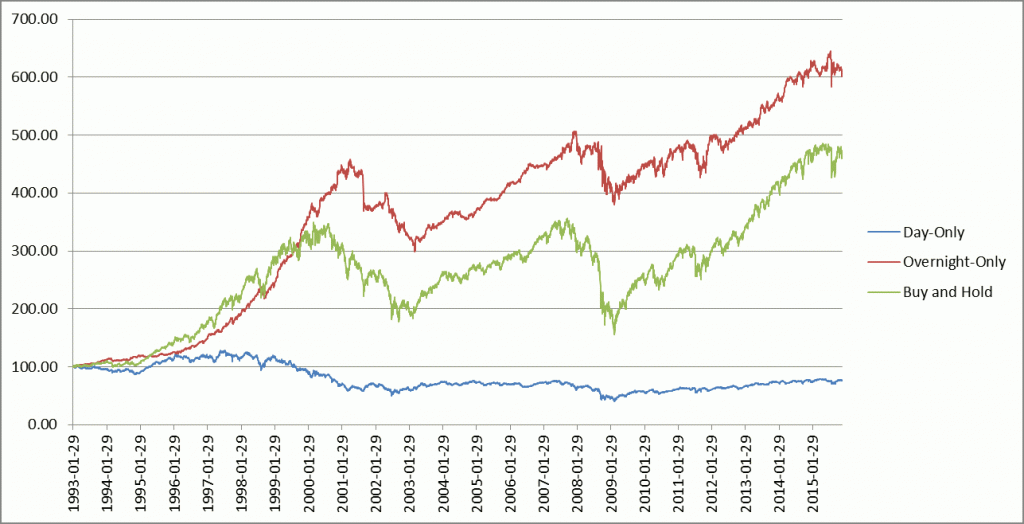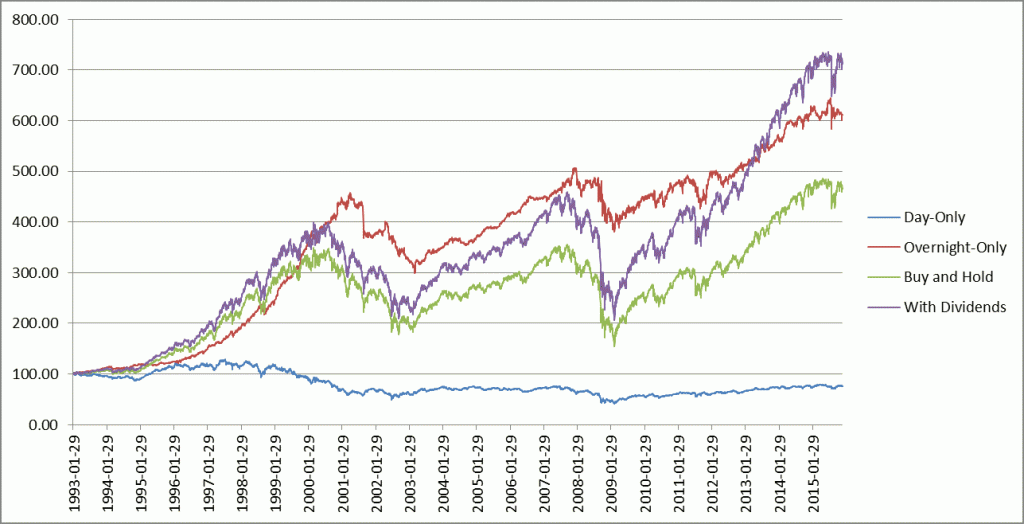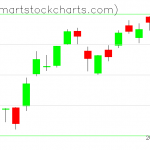If you don’t have an Edge, Buy and Hold isn’t such a bad idea
If you don’t have an Edge, Buy and Hold isn’t such a bad idea
I’ve read a study done by Bespoke Investment Group demonstrating that an investor who sold the S&P500 at market open and bought it back at the close would outperform a buy and hold investor in the S&P500 before taxes, commissions, and dividends. (Sadly, the link to the study is broken as of this writing but here’s an archived copy if you’re interested.) Conversely, an investor who bought the S&P500 at market open every single trading day and sold it at market close would not only underperform the index but also net a negative return since 1993!
Here’s a graph comparing the performance of the Day-only (buy at open, sell at close), the Overnight-only (buy at close, sell at open), and the buy and hold strategy all using the SPY ETF from January 29, 1993 to December 17, 2015:
A $100 investment in SPY in 1993 would be worth $466.25 in December 2015 (not including dividends.) If you went to cash during the trading hours and bought back SPY at market close, your investment is worth $612.22 today. And if you went to cash overnight and only held SPY during trading hours, your investment is only worth $76.16 today!
If the performance of the S&P500 during a particular period is a generalization of how an average investor performed during that period, then what does the blue line in the chart above (corresponding to an investor who only holds the S&P500 during market hours and liquidates the position overnight) represent? It’s the average performance of day traders, who don’t hold positions overnight! No wonder so many day traders lose money!
Btw, another study done by Price Action Lab in response to Bespoke’s study shows that even the supposedly superior strategy of only holding the SPY ETF overnight would quickly go to ruin due to the cost of commissions. (Right, there was no Robinhood back in 1993 so those commissions are gonna take a chunk out of out your profits every single day.) But suppose you had the privilege of trading a much larger account relative to the commissions (say a $1 million account and paying only $5-10 per trade.) Would you still beat the buy and hold investor who has the privilege of collecting dividends?
The buy and hold investor who collects and reinvests his dividend checks will eventually beat the overnight-only investor after about 20 years in early 2013 and would continue to stay ahead as of December 2015. Let’s throw the idea that “past performance is no indication of future performance” out the window and suppose the performance over the last 22 years portends the performance in the future for all 4 equity curves above. Does that mean that buy and hold is utterly superior to holding overnight (assuming you’re using a zero or negligible commission broker like Robinhood)?
By just eyeballing the chart, we can see that the Overnight-only strategy had a much milder drawdown from 2001-2003 than the buy and hold strategy’s approximately 50% drawdown in 2008-2009. Furthermore, the buy and hold strategy also seems more volatile from the chart. Crunching the numbers, here’s a brief breakdown of some vital stats of the two strategies:
| Overnight | Buy and Hold | |
| Annual Return: | 8.24% | 8.96% |
| Volatility: | 10.17% | 18.90% |
| Max Drawdown: | -34.76% | -54.74% |
| Sharpe (r=6.75%): | 0.1467 | 0.1169 |
However, Buy and Hold isn’t the clear winner either
While the overnight and the buy and hold investors have similar overall returns, the overnight investor has considerably less volatility and drawdowns over the last 22+ years while the buy and hold investor has considerably less work to do: just set and forget! I suppose it all comes down to your personality and psychology in the end: if you’ve got a tax-exempt or tax-deferred account with Robinhood and have a constant desire to do something about volatility and be in control all the time, then holding the S&P500 overnight might be a suitable strategy. If constantly trading and checking your investments brings you a ton of unnecessary anxiety, then you’re better off with a buy and hold strategy.





